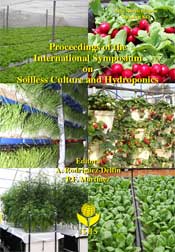Ver ítem
- xmlui.general.dspace_homeCentros Regionales y EEAsCentro Regional Buenos Aires NorteEEA San PedroArtículos científicosxmlui.ArtifactBrowser.ItemViewer.trail
- Inicio
- Centros Regionales y EEAs
- Centro Regional Buenos Aires Norte
- EEA San Pedro
- Artículos científicos
- Ver ítem
Wood waste characterization for composting
Resumen
Use of composted wood wastes has beneficial effects on soil physical and chemical conditions and on crop productivity. This paper includes compositional data from thirteen different wood industry wastes, including bark, chips, and sawdust from three Eucaliptus, Populus, and Salicaceae species, hardboard dust, mud from paper industry and raw cork. Particle size, pH and conductivity on the 1:10 waste:water extract, organic matter (ignition), organic C,
[ver mas...]
Use of composted wood wastes has beneficial effects on soil physical and chemical conditions and on crop productivity. This paper includes compositional data from thirteen different wood industry wastes, including bark, chips, and sawdust from three Eucaliptus, Populus, and Salicaceae species, hardboard dust, mud from paper industry and raw cork. Particle size, pH and conductivity on the 1:10 waste:water extract, organic matter (ignition), organic C, total N, N-NO3, N-NH4, total Ca, Mg, K, Na, Cu, Mn, P, and Zn were determined. The C:N ratio was high in all of the materials (69 to 358), suggesting that it would be necessary to add N to help microorganisms to decompose the wastes. All wastes showed low N-NH4, P, Mg, K and Na content. N-NO3 varied from 259 to 829 ppm, with hardboard dust and mud from paper industry showing the highest values. Ca content was highest in the bark of the three species (1.91 to 5.60%). Cu content was highest (132 ppm) in mud from paper industry, while Zn was highest in the bark of Salicaceae species. The bark of Eucaliptus rostrata Schlecht and Eucaliptus saligna Smidth showed acceptable Mn content. This study shows that the different wood wastes tested are promising materials for composting and use in intensive cropping soils
[Cerrar]

Autor
Gonzalez, Joaquin;
Del Pardo, Cecilia Karina;
Martín, Susana;
Fuente
Acta horticulturae 843 : 337-342 (oct. 2009)
Fecha
2009
Editorial
ISHS
ISSN
2406-6168 (en línea)
0567-7572
0567-7572
ISBN
978-90-66056-52-7
Formato
pdf
Tipo de documento
artículo
Palabras Claves
Derechos de acceso
Restringido
 Excepto donde se diga explicitamente, este item se publica bajo la siguiente descripción: Creative Commons Attribution-NonCommercial-ShareAlike 2.5 Unported (CC BY-NC-SA 2.5)
Excepto donde se diga explicitamente, este item se publica bajo la siguiente descripción: Creative Commons Attribution-NonCommercial-ShareAlike 2.5 Unported (CC BY-NC-SA 2.5)

